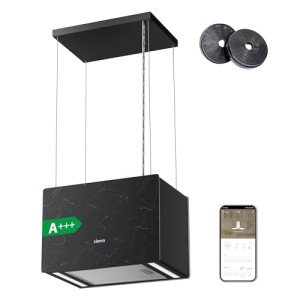The Most Popular Island Vent Hood The Gurus Are Using 3 Things

How to Ventilate an Island Vent Hood
Suspended from the ceiling, an island vent hood assists circulate air and keeps your kitchen without smoke and odors. It's also a stylish feature that improves your cooking space.
Ventilation types consist of external venting, which pushes air through ductwork to the exterior of your home, and recirculating models that filter and recycle cooking fumes. Some hoods can even be transformed in between one and the other.
Ventilation
Unlike wall-mounted range hoods that vent air vertically through the wall to the outdoors, island vent hoods utilize ductwork that goes through the ceiling to tire the cooking area to the outdoors. The difference is that they can likewise be used to recirculate air.
Discover our selection of business and designer custom-made hoods with effective ventilation systems. With adjustable specs, discover the ideal hood for your kitchen area.

Dacor's ConnectOn auto-responsive technology turns on the hood and ramps up the fan speed in response to the cooktop, providing effective performance while using minimal sound. It's simply another method that you can cook with confidence. Add a touch of contemporary with this stainless-steel pyramid-style wall-mount canopy hood. This hood gracefully accentuates advanced kitchens that follow a more standard design style and clarifies of smoke, steam and cooking smells.
Style
Unlike wall-mounted range hoods that are installed versus the wall, island vent hoods are suspended from the ceiling over an island or peninsula cooktop or range. They also use ductwork to exhaust air out of the home. This style is perfect for kitchens that have a lot of open area, and it assists to add visual interest to your space. This brand-new home features Blackberry stained cherry kitchen cabinetry on the specification, and a natural stacked stone on the island and vent hood to complement the Gunstock stain on the cabinets. 10ft ceilings and a skylight help to keep the kitchen bright and roomy.
Sound
While an island vent hood does a terrific task of filtering smoke, grease and smells out of your kitchen, it can also develop some noise that disrupts the serenity of your cooking area. Fortunately, there are some strategies you can employ to lower this sound and permit you to prepare in peace.
Among the primary causes of excess range hood sound is triggered by fan motor problems such as stiff bearings or improperly lubricated fans that produce a loud humming noise. Ductwork can likewise contribute to this problem especially if the ducts are too small or if they are blocked with dust.
The very best method to reduce noise is to ensure that your vent hood has the greatest air flow rating that you can pay for. The Home Ventilating Institute (HVI) recommends an air flow rate of 100 to 250 cfm for wall-mounted hoods over 30-inch large stoves. island extractor hood to also have a multispeed fan to enable lower fan speeds throughout light cooking. One of the most basic methods to minimize the sound is to make sure that the ducting is smooth-walled, as corrugated duct limits airflow. You need to also keep the duct runs as short and straight as possible to avoid any kinking.
Setup
Ventilation of island range hoods is a different procedure than wall-mounted units, because they are suspended from the ceiling over an island or peninsula cooktop or range. They typically require a duct that goes through the ceiling and out through the roofing, which can be a complex task for an unexperienced homeowner.
In addition, they must be installed at least 24-inches to 36-inches above the cooking surface area. The height might vary, depending upon the size of the hood and the ceiling. If you have existing ducting and electrical wiring in the kitchen ceiling, this kind of vent hood is relatively easy to install. If not, it's suggested that you seek advice from a professional.
To start installation, ensure the hood can fit through the opening you have actually selected for the vent and that it's the best width to accommodate the ductwork and exhaust. If the hood is too broad, it can reduce the effectiveness of the vent and will increase sound levels. Next, cut a little hole in the ceiling and utilize a wire cutter to inspect that there's no plumbing or electrical circuitry near the hole. If there is, think about hiring an expert for the job or switching to a recirculating system.
If there isn't, you can start the bigger vent hole by drilling locator holes with a drill and a 1/2-inch masonry bit in each corner of the area. Then utilize a jigsaw to cut the larger vent hole. Lastly, add a drywall spot and paint to finish the job. As soon as the hood remains in place, you can run the electrical wiring and link it to your breaker box. Follow your producer's guidelines for complete setup information.
